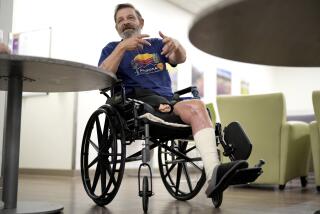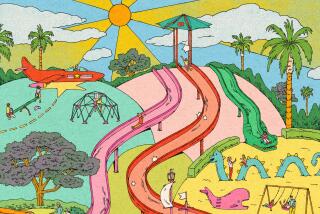How Safe <i> Is</i> Your Local Playground? : Safety: Children get hurt while playing on hard surfaces. Watch out for asphalt, concrete, compacted grass or dirt under swings and slides, experts say.
- Share via
Warmer weather brings more playground time for children. Yet these play areas sometimes require extra precautions to keep them safe for youngsters.
The federal Consumer Product Safety Commission estimates that 17 youngsters die annually from playground-related accidents. According to the commission, an additional 150,000 children are hurt badly enough to require treatment in an emergency room.
Falls are the leading cause of injury. They account for 75% of serious playground accidents, according to the Consumer Federation of America, a nonprofit group that issued a report on playgrounds last month and advocates tougher safety standards for play areas.
To reduce injuries, the CFA and other groups, including the American Academy of Orthopedic Surgeons, recommend that playground surfaces be made of materials to cushion falls. “Hard-paved surfaces including asphalt and concrete . . . are not acceptable under and around play equipment,” the CFA report noted. The reason: None of these surfaces can adequately protect children from head and other injuries.
Even grass, soil and sand can sometimes be dangerous. Grass is usually worn thin by heavy foot traffic around play equipment. Dirt becomes compacted and hardened. Sand can provide good cushioning, except after it gets wet, when it also becomes compacted and hard.
Wood mulch, chips or shredded bark mulch are the best bets for play areas, said Mary Ellen Fise, co-author of the CFA report. But they must be “fairly deep and well maintained to offer the best protection,” she said.
The CPSC tested surface materials to see what offered the best protection from life-threatening head injuries. The higher the equipment in a play area, the deeper the ground protection must be, according to CPSC tests. For example, a nine-inch layer of uniform wood chips can cushion the fall of a child from a seven-foot-high platform, the tests showed. But when those wood chips are compressed, the safe height drops to six feet.
The CPSC tests also showed that a six-inch layer of uncompressed fine sand protected against a fall of five feet--the same as a nine-inch layer of wet, compressed sand. Even with adequate cushioning on the ground, falls from any level can produce injuries depending on how a child lands. That’s why parents need to regularly inspect play areas, Fise said.
At home, mulch needs to be raked often to maintain depth underneath equipment where children are most likely to fall, such as platforms, slides and swings. They should add mulch regularly to compensate for compression or normal wear and tear.
Parents should closely examine the public playground their children use. Don’t assume, Fise said, that it is safe. “We (encourage complaints) to the appropriate people if (parents) find a dangerous area,” she said.
In addition to protective surfaces, look for:
* Equipment too close together.
* Equipment too high off the ground. The CFA recommends that platforms and slides for preschool children not exceed six feet and those for school-age youngsters should be no higher than seven feet.
* Inadequate guardrails or protective barriers on platforms, walkways and ramps that could allow a fall.
More to Read
Sign up for Essential California
The most important California stories and recommendations in your inbox every morning.
You may occasionally receive promotional content from the Los Angeles Times.













